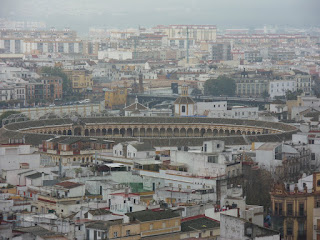It’s another place that photos really can’t capture, and I’d recommend you google image it to get some great aerial views that will show you how big it is.

Originally, there was a great mosque on the same site, which was then adapted to Christianity in the 8th century, when Christians took over Sevilla. There are still a few elements of the original mosque present such as the patio of the orange trees and the Giralda.

Here's a picture of the patio of orange trees. This is where Muslims would wash before entering the mosque.
In 1401, plans were made to destroy the current structure and build a new gothic cathedral, and the council had the goal that the church be “so big that all who see it will think we are mad”.
Construction began in 1517 with masons from Spain, France, and Germany, and although it would roughly finished by the turn of the 18th century, it was added to up until the early years of the 20th century. That’s a construction period of around 400 years.
And if the size wasn't enough, the extensively decorated interior will change your mind. There are over 50 large stained-glass windows, most of which have been redone numerous times due to the frequent earthquakes in Portugal. Here's a picture of one of the larger ones (although when the sun shines in it's tough to get perspective):

It's worth noting that for many, this would be a pretty great place to be laid to rest (I'd prefer a plot next to my lake at home where I've buried a few cats). Here's a picture of a famous Cardinal who died just before ascension to the Pope:

And I guess it's also worth noting that Cristobal Colon also rests inside this cathedral. For all you non-spanish speakers out there, that's Christopher Columbus! These remains have been heavily disputed in the past because both San Salvador and Madrid both claim to have Columbus' remains. Interestingly enough, DNA testing has proved that all three do in fact have Chris' remains (How they got the initial DNA to perform the test is a question beyond my grasp of the spanish language). This fact of course questions either the integrity of the DNA test, or the integrity of Columbus' family...or both. But anyway, here's his coffin:

The four pall bearers represent the kings of the four realms of Spain during Columbus' voyage, a couple of which carry staffs with crosses on the top and a Muslim image on the bottom, representing the triumph of Christianity that Columbus' voyage apparently brought. Say what you want about the man's beliefs, navigational prowess, and all the diseases his men brought to the New World, but don't think you wouldn't have done the same thing if you had his financial means and courage. If you wouldn't have made the trip, it certainly wouldn't have been out of a knowledge of the difference between European and Western hemisphere bacteria.
The size of this church is absolutely impossible to grasp, but here's a couple ceiling shots to give it a try...



In the middle photograph above, the door below is the main entrance to the cathedral, but is only opened for the King of Spain, or the Pope.
The organ in this place only sounds on special occasions, but from this picture you can tell it's big.
...and that's only half of it. There's an identical organ on the other side of the choir chamber. Each has over 30,000 individual tubes, and although it's automated now, required 3 men to play in the 16th-19th centuries.
In addition to everything else, the construction of this cathedral took place in the golden age of Europe and of Spain, and every one of Spain's greatest artists played some part in the art that adorns many walls of this cathedral. I feel so terrible that I can't remember their names, but that's the way it goes, and in fairness, wiki didn't know, either.

This is the most famous painting in the cathedral, depicting St. Anthony. It's difficult to see, but if you look closely around the figure of the kneeling St. Anthony, you can make out a line that goes all the way along. This is because in the early 20th century, robbers broke into the church, cut out the man from the painting, and sold it on the black market. The figure made his way back onto the grid and was bought by an American. But when he was contacted by the church who had located its whereabouts, he immediately gave it back (go America), and luckily, St. Anthony made his way back home. In such a strange series of events it's a wonder that he wasn't lost for good! In that case it's a good thing St. Anthony happens to be the saint of lost items. Seriously.
With a tour of the grounds and inside complete, we headed up the tower, La Giralda, which is by far the most notable site in all of Sevilla. It is the first thing you notice no matter what road or path you take into the city.
Walking up the Giralda, I was extremely surprised to find that there are no stairs.

This is so that horses could make their way up to the top. Why? That's a question that escapes me, unless it was just the laziness of their riders. (In their fairness, the tower is around 30 stories high).
The tower is still a functional bell-tower, which we experienced first-hand when the clock struct 2pm. Thank my stars it wasn't 11.

Here are some photos I took from the top:
 My favorite street in Sevilla, Padre Merez^
My favorite street in Sevilla, Padre Merez^ The Real Alcazar, or royal fortress, which I discussed in an earlier blog but will be returning to sometime.
The Real Alcazar, or royal fortress, which I discussed in an earlier blog but will be returning to sometime.



No comments:
Post a Comment